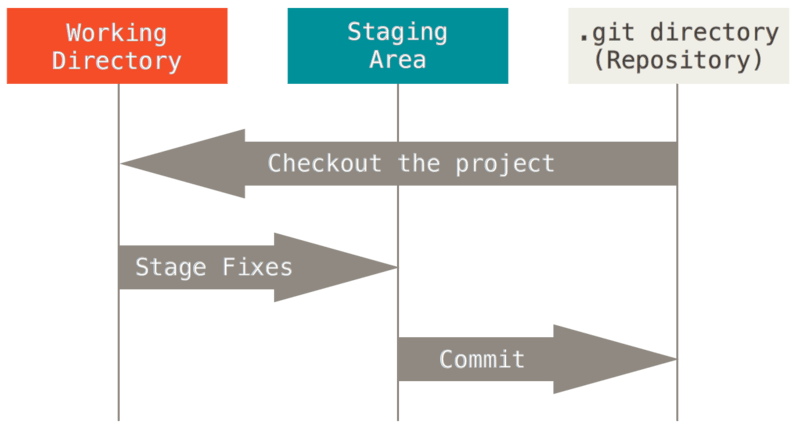$ ls -a ./ ../ .git/ react.txt vue.txt # This is a git repository $ git status On branch master nothing to commit, working directory clean # Not a git repository $ git status fatal: Not a git repository (or any of the parent directories): .git
Simple workflow for solo developers
Using git in your project is simple.
If you already manage you codebase with git, run a git clone to retrieve it.
Otherwise you can turn a regular project into a git repository with git init.
In both cases, you’ll find a .git folder in the project root.
This is the only location where git puts its information about the project versions.
Don’t touch it, it’s not yours!
Another way to check a directory belongs to a git repository is to run git status.
It gives details about the repository.
But not work outside of a git repository.
Add, commit & push
Now you have a git repository, we can begin to go though the basic git workflow. In this context, you can still loose your work by doing anything but you won’t have to deal with conflicts.
Yes, conflicts are tiresome but only happens when you and a felow developer update the same piece of code. This workflow is basically what you might remember if you learned with pratice.
ADD some modified files, COMMIT your changes and PUSH your commit to share it
Here the translation into git commands:
$ git add file.txt $ git commit -m 'Add new file' # The message is required $ git push
First, we’ll focus on add and commit. Git base unit are commits. Its job is to manage commits. They contains modifications between each version of the codebase.
Each commit contains a message which describes it. You don’t need to make it long but be careful about its content. Look at guidelines from Pro Git, it seems a bit too much but still interessting to read.
$ git commit -m 'Write React and Vue introduction'
On branch master
Changes not staged for commit:
modified: react.txt
modified: vue.txt
no changes added to commit
In this example, there are modification on react.txt and vue.txt.
But, you can’t commit there are no changes added to commit.
Well, Git is smart and tries to help you with meaningful feedback.
It’ll not assume you want to commit all changes.
You must select which modified file you want to put in your commit.
That’s what add is made for. Its purpose is to add files in the staging area. When you ask for a commit, git will only include staged files. Other modified files are also in your working directory but won’t be considered.
$ git add react.txt
$ git status
On branch master
Changes to be committed:
(use "git reset HEAD <file>..." to unstage)
modified: react.txt
Changes not staged for commit:
(use "git add <file>..." to update what will be committed)
(use "git checkout -- <file>..." to discard changes in working directory)
modified: vue.txt
$ git commit -m 'Write React introduction'
[master 8342ba8] Write React introduction
1 file changed, 1 insertion(+), 1 deletion(-)
$ git status
On branch master
Changes not staged for commit:
(use "git add <file>..." to update what will be committed)
(use "git checkout -- <file>..." to discard changes in working directory)
modified: vue.txt
no changes added to commit (use "git add" and/or "git commit -a")
On of the most useful command is git status.
It tells clearly which files are modified and if they’re staged for commit.
The green part is the staged area.
Indeed a file can be in three states: modified, staged or committed. I think you can now understand the following diagram from Pro Git.

As explained before, git records everything in the .git directory.
It manages commit so only committed files are in this directory.
Current modifications from the working directory and the stagging area aren’t there.
After a commit the staging area will be empty.
Your working directory is also clean (no modifications) if you added all modified files to the staging area before.
I forgot to tell you about git push.
Git manage codebase versions but also helps synchronise the last version with your colleagues.
The repository is usually hosted on a git server.
When you push, your new commits are send to the server.
Your colleagues will be able to get the last version.
Here a last thought about files changes.
You can have files in your directory git don’t know about, they’re untracked.
It happens when you create a new file in your codebase.
A simple git add will tell git to track it.

Files in git can be in four states.
By default every known (or tracked) file is unmodified.
You can see the file states with git status.
$ git status On branch master Your branch is up to date with 'origin/master'. Changes to be committed: (use "git reset HEAD <file>..." to unstage) modified: index.js Changes not staged for commit: (use "git add <file>..." to update what will be committed) (use "git checkout -- <file>..." to discard changes in working directory) modified: letters.js Untracked files: (use "git add <file>..." to include in what will be committed) colors.js
This command is pretty verbose but comes with many details. They are a maximum of three sections corresponding to three file states:
-
Changes to be committed (Staged)
-
Changes not staged for commit (Modified)
-
Untracked files (Untracked)
You can’t see Unmodified files because it’s not relevant, what’s important are modifications, the rest is already saved in git.
Still, it’s possible to display a list of all tracked files using git ls-files .
The output will include all files not in the untracked part.